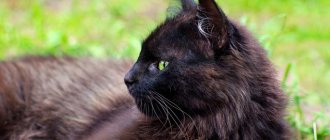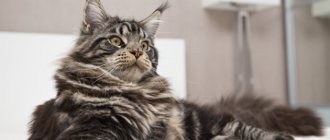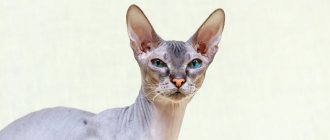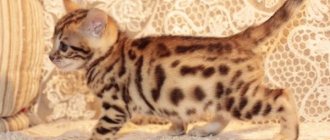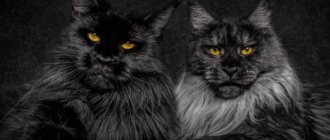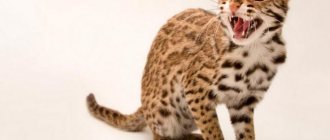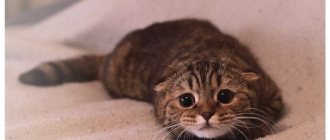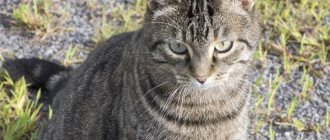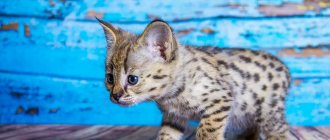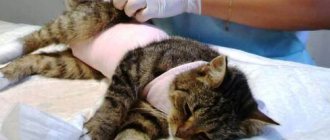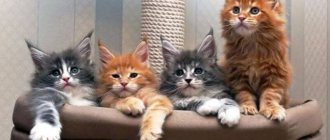Save article:
Before purchasing a long-haired cat, remember that similar breeds, such as Persian and Angora, require constant care. The length of the coat of these breeds sometimes exceeds 10 cm, and with infrequent brushing, tangles form. So make sure you have time in your schedule to set aside about 30 minutes a couple of times a week to groom your cat.
.
global $ads_google; //data-ad-slot=”2475549904″ $ads_google = empty($ads_google) ? false : true; ?> if ($ads_google == false) {?>
$ads_google = true; ?> } ?>
For care you will need special equipment: a brush with natural bristles; combs with teeth of various frequencies and blunt ends, scissors with rounded edges, used for cutting out matted wool. Antistatic spray and powder are also used to facilitate care procedures.
When combing the fur on the face and paws, a slicker brush is used; its use is not recommended for other parts of the body, as there is a risk of damage to the structure of the undercoat, which can be slowly restored. Combs with teeth of varying densities and blunt ends will come to the rescue here. When combing out tangles, combs with teeth of various lengths are used. It is not recommended to use plastic equipment, as wool becomes electrified when interacting with it.
It is recommended to adhere to the following combing order: start with the head and neck, move to the back and sides, then the chest, belly, paws (start with the hind legs, pay attention to the armpit area). It is necessary to finish combing on the tail, which requires minimal impact. First, combing is done with a soft brush against the hair, then along the hair. If the fur is initially very tangled, then first use a sparse comb, and only after that take up the brush. An antistatic spray can be applied to combed fur, but the product cannot be used during the first year of the animal’s life. Additionally, you can apply talc to the wool, which will help it become less tangled, and for additional shine, you can use a solution of citric acid.
How cats are classified according to their fur
Different coats require different approaches, so you need to know into which groups all domestic cats are divided according to coat length. This is very important when choosing tools for caring for an animal.
If you look at different cat breeds, you will notice that the texture of the coat, its length, density and even position on the body are completely different.
That is why there are six official classifications of these breeds:
Photo: Persian cat
- long-haired. The fluffiest representatives of the cat kingdom, requiring more care for their fur coat. These are Siberian, Norwegian Forest, Persian and Burmese cats;
Photo: Abyssinian cat
- shorthaired. Very cute and respectable pets who prefer a “strict” style. Representatives of this group: Abyssinian, Oriental, Thai and Scottish cats;
Photo: Neva masquerade cat
- semi-longhaired. Cats classified in this group are the owners of particularly charm and sophisticated beauty. The brightest and most unusual representatives of the class: La Permas, Maine Coons, Cymrics, Turkish Angoras, Van and Neva masquerade cats;
Photo: American Wirehair cat
- wire-haired. The smallest class of cats by coat, consisting of a single breed, the American Wirehair. The main feature of these pets is their unique coat texture: fairly hard hairs lie unevenly, densely, some curl (even behind the ears), while others stick out funny or suddenly break;
Photo: Cornish Rex
- with curly hair. Representatives of this group have an unusual, elegant appearance. The cats are dressed in stunning fur coats that appear wavy from a distance. Representatives of this class: Cornish Rex, Devon Rex and German Rex;
Photo: Don Sphynx
- hairless. The cats of the last group have no fur at all. Their exotic appearance attracts people's attention. Representatives of this class: Canadian and Don Sphynxes, Peterbalds;
Photo: Likoi
- The Lykoi do not yet belong to any of the named groups. The fact is that these fairy-tale werecats are bald in places, and there is no undercoat at all.
Also, all cats are divided into two large groups:
- with undercoat (Russian Blues, Abyssinians, Kuril Bobtails, exotics). Require more careful care;
- without undercoat (Oriental, British, Burmese, Siamese). They practically do not shed and are very easy to keep.
Animal care during and outside the molting season
In order not to think about how to remove cat hair from various surfaces, and especially not to have to do long cleaning, you need to know how to properly care for the animal. It’s interesting that short-haired pets’ hair falls off, while long-haired pets’ hair falls out in clumps or rolls into clumps (popularly called “tangles”). For animals with long hair, you will need a brush with a steel or chrome coating and brushes made of natural bristles. For pets with short hair, a brush mitt is suitable to remove dead hair.
During the molting period, you need to adhere to several rules:
- As soon as shedding begins, the animal should be bathed. A special coat balm is suitable as a detergent. After the fur has dried, the pet should be thoroughly combed with a brush or slicker. These accessories should be selected according to the animal’s specific breed.
- The animal should be combed every day throughout the cat lint shedding season. If you do it several times a day, that’s just great. Long-haired pets should be groomed twice a day at a minimum. Thanks to combing, the amount of shed fur is reduced significantly, and the pet’s skin is also healthier.
- The final stage: stroking the cat with wet hands. This way you can collect the uncombed wool, roll it up and throw it in the trash.
Unfortunately for humanity, it is rare that any breed does not shed. And some shed fur all year round. So what should the owner do then? It is necessary to identify the cause of molting and eliminate it.
- Some breeds require daily brushing. These include the beloved British. They should do their “hair” with a special brush.
- Year-round molting (except for the first point) indicates health problems. As a rule, the pet lacks vitamins and microelements, so the fur falls off in clumps. Or perhaps a disease. In any case, you need to go to the veterinarian and consult.
- If the house is too dry and stuffy, then the animal will actively shed its fur. In order not to wonder how to get rid of cat lint and fur in the house and not waste time on cleaning, you need to humidify the air in a timely manner and, if possible, reduce the temperature in the room.
How to care for cat fur at home
Having understood such a broad classification, you can finally find out exactly how to care for the fur coat of a cat of a particular group. The good condition of an animal's fur lifts its mood and also improves its well-being.
Regular care of your cat's coat will help get rid of fats, debris, dust, dead pieces of epithelium and villi accumulated in the hairs and on the skin, and also prevent the appearance of parasites. Remember that each type of coat requires an individual approach.
Short-haired
Short-haired cats are easier to care for. To keep their coat in order, you won’t need constant hours-long sessions of combing, bathing, straightening hairs and getting rid of formed tangles.
Photo: caring for short-haired cats is very simple
In fact, creating the perfect look for your pet is not as difficult as many imagine. And you will spend little time and effort on preening your pet.
To care for a short-haired cat you will need:
- bristle brush;
- massage brush with large rubber teeth;
- a small slicker brush (a brush with thin curved wire teeth);
- two metal combs with rounded edges: a comb with fine teeth and one with sparse and thick teeth;
- a special embossed rubber mitten or brush with flexible protrusions;
- special or baby shampoo;
- As a supplement, you can purchase a special powder that improves the appearance and structure of the coat.
Trust me, you don't need to brush your pet every day. It is enough to go over the animal’s fur coat with a soft bristle brush a couple of times a week to remove dead hairs and possibly any debris found there.
Afterwards, go over the hair growth direction with a rubber mitt or an iron comb to create a beautiful styling.
To make the coat look amazing, you can apply powder or a special lotion after the procedure.
Long-haired
Beautiful cats with long fur require careful daily care. Due to the structure of the fur coat, you will have to devote enough time to make your pet look its best.
Photo: long-haired cats require daily care
Sometimes this needs to be done extremely carefully, so it is very important to know how to care for the fur of a fluffy cat.
In addition to the tools and tools already listed above, the following may be very useful to you:
- double-sided round comb with plastic teeth of different frequencies;
- strong iron comb;
- durable metal powder brush;
- tangle cutter
It is recommended to comb your cat thoroughly every day, then putting your pet in order will only take you a few minutes. One of the most unpleasant problems when caring for a pet's fur coat is tangles.
If you find them, you should not worry too much or resort to extreme measures (cut off the affected part). Take a comb and, holding the problem area of fur with your fingers, begin to slowly comb out the tangle.
Don’t delay the operation to save the beauty of your cat’s hair! Otherwise, the tangle will only become larger, and it will be almost impossible to get rid of it and you will have to remove the matted lump with a tangle cutter or scissors.
Semi-longhaired
Caring for semi-longhaired cats is slightly different from caring for long-haired breeds. The fur coat of such pets is more stable, less dirty and tangled.
Photo: semi-longhaired cats are more resistant to pollution
It is worth considering some of the characteristics of the pets themselves when selecting tools, vitamins and bathing products.
To get your cat in order you will need:
- a soft bristle brush and a hard wire brush;
- quite powerful powder brush;
- a piece of soft suede (for styling a fur coat);
- silicone massage glove;
- non-toxic lotion and shampoo;
- combs with frequent and rare teeth.
Cats in this group do not require daily brushing; only two or three times a week is sufficient. Particular attention should be paid to the areas of the chest, panties, and belly.
First, carefully go over the entire fur coat with a soft brush, combing out dead hairs with smooth movements.
Then straighten the fur with a comb and lay it out. You can also give your pet vitamins containing biotin once or twice a year.
It is worth mentioning the peculiarities of the coat of light-colored pets. The problem is that even the slightest dirt on them is very visible.
Next, you will learn how to care for the fur of a white cat. You should arm yourself with simple medical alcohol, which will easily remove all stains from your fur coat. Otherwise, caring for a white cat is completely the same as standard.
Caring for Persian cats
The hair of Persian cats is long, light and fluffy. With poor care, it quickly gets tangled and rolls down to such an extent that sometimes the only way to cope is to cut off the problem area. Particular attention should be paid to grooming during shedding, otherwise the cat may experience digestive problems due to ingestion of hairballs. And the owners will have to collect wool from the floor and interior items.
To preserve the rich color of wool, talc, starch or powder are used. To make it even more decorative, you can trim off the excess hair on the cat’s ears. The condition of the coat can be further improved by trimming hairs that stand out in length or color.
What's the best way to train a cat to groom?
Not all cats like to be brushed. Some are hostile towards grooming tools and try to grab or bite them, others mistake what is happening for a game, and still others get scared just when they see a brush in a person’s hands and try to quickly hide.
Photo: It is very important to train a cat to groom
The following tips will help you quickly achieve a calm animal response to care:
- It is best to train a cat to brush from an early age (you can use a clicker or a system of treats);
- Before combing, stroke and calm your pet;
- talk to the animal;
- work slowly and smoothly.
Eye hygiene in furry cats
The fur on the face is the place where the cat takes care of the hygiene of dead hairs 100%, but she can no longer clean her eyes. In this case, it is doubly difficult for long-haired cats - the hairs constantly loom near the eyeball and either stick to it, or carry dust, or even provoke the development of conjunctivitis or some more serious disease of the eye or eyelids.
In this regard, the owner of a fluffy cat is required to carry out a daily ritual of cleaning the cat’s eyes using a cotton pad and a chamomile solution or a special solution from a veterinarian. Of course, the cat won’t come into the bathroom every hour and remind you that it’s time to wash your face. Therefore, just make it a rule: if you wash yourself, wash the cat.
Another advantage of the procedure is that you will be able to notice any signs of developing eye disease in the early stages and promptly contact a veterinarian for help in treatment.
What devices to use
Some devices have already been mentioned in the instructions for caring for cats.
Photo: for proper hair care you need different devices
You will need the following tools to make your pet look like a TV star:
- combs (with frequent and rare teeth);
- slicker;
- massage brush-mitten;
- iron combs with fine teeth;
- brushes made of natural or synthetic bristles;
- tangle cutter and scissors;
- double-sided brushes;
- spray, shampoo, lotion and balm.
Why is it better to comb than not to comb?
Many short-haired representatives of the cat family have hair lengths of 4-5 centimeters, while long-haired ones have hair lengths of 13 centimeters or more.
Hairs fall out from time to time and get stuck in the cat's fur.
If you do not comb out these hairs, then some of the hair will be all over the apartment, and the pet will eat some of the hair when washing.
The surface of a cat's tongue is covered with pointed depressions that resemble a grater. Such tubercles are turned closer to the lingual root, so all the hairs are pulled towards the animal’s mouth and swallowed. All licked hair accumulates in the stomach in the form of balls of wool, shaped like tubes. These wool balls can clog the stomach or cause nausea (vomiting) in your pet.
Therefore, it is better to comb the wool.
How to care for short-haired cats?
First, comb out with a fine-toothed comb, and then with a soft rubber brush.
The cat should be combed using brushes, first from the scruff to the tail, then in the opposite direction.
In order for the animal's fur to lie smoothly, you just need to stroke it more often!
How to care for long-haired cats?
It is advisable to brush long-haired cats every day.
First we comb it with a comb with sparse thick teeth, then with more frequent teeth in the direction of hair growth.
If the coat is very long, then it is better not to take risks and not to scratch against the grain.
If your cat has tangles - this is fur matted in a ball - then you can try to untangle them with your fingers. If it doesn’t work, then you can try to take a blunt knitting needle or not very sharp scissors and stick it into the tangle and follow it from the beginning of hair growth to the end. Very carefully, it will hurt your pet if you pull its fur. If you can’t untangle it, you’ll have to cut it off.
How often can you bathe your pet?
The number of baths per month for cats depends on the length of the coat and the characteristics of its structure. Although the pet itself is quite clean, it cannot remove all the dirt from itself.
Photo: bathing a cat will rid the animal of dirt and old fur
Short-haired cats need to be bathed infrequently, about two to three times a month. Then apply the balm and wash it off after five to ten minutes. Such procedures help to significantly improve the quality of your pet’s coat.
Do not forget that combing is necessary after taking a bath to avoid matting of the fur coat.
It is recommended to wash semi-longhaired cats as needed. If the body becomes dirty or an unpleasant odor appears, bathe the animal using a special shampoo, conditioner and conditioner. Then dry the coat with a towel.
Long-haired cats need to be bathed a little more often than short-haired and semi-long-haired cats, about once or twice a month. You can use a special softening shampoo and lotion to make the coat silkier.
If you notice a little dirt on your cat’s coat, you don’t have to repeat the water procedure, which is unpleasant for the animal.
You can use dry wool cleaning products. A special spray, which can be purchased at most pet stores, must be sprayed onto the contaminated area and left to soak in for a few minutes. Then wet a napkin or handkerchief with water and wipe the stain.
But in the fight against greasy fur, similar to icicles, which is most often found in the neck and ears (where the cat cannot wash itself), a special powder can help.
Gently rub the product into the fur coat and leave for a few minutes. Then comb out the powder with a bristle brush.
How to avoid the formation of tangles?
In long-haired cats, the risk of matting is several times higher than in short-haired cats. Tangled areas of fur left unattended can cause serious harm to the animal. For example, a cat may try to get rid of them on its own and end up scratching its skin. In addition, areas of the skin under the matted fur begin to swell and itch. And if the tangled lump is not removed in time, a skin disease may develop that requires medical intervention.
If the pet owner cannot remove the mat on his own, he should contact a specialized salon, where experienced craftsmen will carefully cut the hair without damaging the animal’s skin.
What should the owner do to prevent the cat from developing tangles? Necessary:
- comb (at least three times a week);
- use specialized detergents and shampoos that prevent hair from becoming tangled;
- Monitor your pet closely, and if you find a tangled area of fur, comb it yourself or contact a specialist.
The care and attention of the owner will make the cat beautiful, happy and well-groomed.
Is it worth cutting a cat's hair?
Some owners ask veterinarians whether it is worth cutting their cat’s hair to speed up shedding, make it feel better in the summer, prevent hairballs from appearing in the stomach, or to create a decorative “hairstyle.”
Photo: Grooming cats does more harm than good
However, such a measure will not only not benefit the animal, but will also cause harm. Hair clipping can lead to:
- to changes in the structure of the hairs (they become thinner and brittle);
- to stop hair growth;
- to the occurrence of alopecia.
Caring for a cat's fur depends on the length of the coat and its structure. With just a little effort, your pet will look amazing.
Fluffy cat breeds
Beauty, as you know, requires sacrifice. But millions of true fans of fluffy cats are not afraid of either victims or cat hair - and it materializes everywhere: on carpets and sofas, clothes, in the corners of rooms and even in food... If desired, these problems can be dealt with for the sake of incomparable pleasure admire your pet and stroke its wonderful soft fur.
Fluffy happiness will always be by your side
If, for example, for a Siberian or Norwegian forest cat, a luxurious fur coat has become not a matter of prestige, but a need to survive in a harsh climate, then most breeds, especially young ones, are now formed on the principle of maximum decorativeness, and beautiful long fur is a great way to make them even more attractive and in demand.
Photo gallery: such different pet furries
Maine Coon is the largest fluffy cat
American Bobtail Longhair - big, strong and very kind
Persian is the fluffiest and longest-haired
Munchkin longhair - charming short-legged
Ragamuffin - a type of ragdoll
The Himalayan cat is energetic but flexible
The Siberian cat is a popular native breed
Sacred Burmese - an aristocrat with a legendary history
Oriental Longhair - a breed originally from the East
Neva Masquerade - a subspecies of the Siberian cat, bred into a separate breed
American Curl - a cat with elf ears
Turkish Angora is an ancient breed that has gone through a long process of selection.
Balinese - semi-long-haired Asian with increased activity
Video: the most popular fluffy cats
Persian cat
Persian cats are probably one of the most popular and widespread decorative breeds in the world. The Persian has earned such wide popularity precisely because of his incredible super fluffiness. Although this animal has other advantages - the furry beauties are full of nobility and self-esteem. But their imposing appearance can mislead anyone.
The Persian is the clear leader in cat fluffiness ratings
In fact, a fat and fluffy Persian is not at all such a phlegmatic “bun” as he may seem at first glance - this cat may unexpectedly turn out to be too active, expressive and even aggressive - if disrespect for his rights and personal territory is shown.
Persians are cat champions in terms of fluffiness; they have no equal here. But this is exactly the case when beauty does not come easy. A cloud of Persian wool will require constant care - otherwise it will look deplorable, and all surfaces in your apartment will be covered with a layer of delicate fluff, which even a vacuum cleaner cannot always handle. Then there will be only one way out, which, alas, many owners resort to - “removing” the tangled fur coat under the machine. However, the Persian's fur has the enviable ability to quickly grow back. Its length in an adult animal can reach 20 cm!
Video: everything about the Persian cat
Maine Coon
The handsome Maine Coon is good in all respects. This large, showy cat is endowed with a friendly character and high intelligence. Although, I must admit, the cat’s giant grooming is serious and even a little gloomy.
Maine Coon is also called raccoon cat
Maine Coons are famous for their beautiful shaggy coat with a well-developed undercoat. Their special pride is their magnificent collar and very fluffy long tail. If you don’t neglect the condition of the “raccoon cat” clothes too much, then there won’t be any problems with them. Comb your fur coat at least once a week and don’t forget to use a furminator during seasonal molting - this will be quite enough.
Video: Maine Coon - Guliver of the cat world
Bohemian rex
Flirty curly cats were first introduced to the world in the 1980s in what was then Czechoslovakia. In appearance, they most closely resemble the “permed” Persian, but they are completely different animals.
The breed was developed in Czechoslovakia
To the touch, these cute curls are very thick, delicate and soft - not even like a cat’s, but like a llama’s. Needlewomen claim that “Bohemian” fluff makes excellent yarn - fluffy and unusually warm. But, as you might expect, such exclusive wool will require careful attention. It will need to be combed daily, and in addition, a curly pet will need special super-premium food and supplements with vitamin B6, which will help maintain the structure of the curls in proper condition.
The predominant and most popular colors of this curly miracle - blue, cameo, cream, smoky, tortoiseshell - in their own way emphasize the amazing tenderness and sophistication of this extraordinary cat.
Norwegian forest
A very charismatic and bright animal in character, the Norwegian Forest is not suitable for everyone, but those who can find a common language with it will be delighted with such a pet.
Norwegian Forest - beauty, smart and huntress
The Norwegian cat has a very thick coat with a unique structure - a soft and long outer layer harmoniously combines with the lower, thick and oily one. This natural feature of this magnificent coat allows you to limit its care to weekly combing. But of course, during the spring molting period, the coat will require additional care - and this will only be in your interests.
An excellent hunter by nature, the Norwegian cat is always mobile, sociable and active. She has her own opinion in everything, but at the same time she is quite capable of compromising with others.
Video: Norwegian Forest Cat - charismatic charm
Neva Masquerade
It's hard to believe that this sophisticated and refined animal is the sister of the powerful, strong and very characteristic Siberian cat. The Neva Masquerade, descended from a Siberian and a Siamese, was identified as a separate breed, which rapidly gained popularity and is a source of well-deserved pride for St. Petersburg breeders and felinologists.
Neva Masquerade - blue-eyed pride of domestic selection
This is a sweet family cat, loyal and inquisitive, who has a lively personality and good health. Her ancestors gave her wool of excellent quality, but maintaining this beauty in decent condition is still the task of the owners. Don't forget to brush your pet regularly and bathe it once a month.
The smooth-haired Neva masquerade cat is perhaps the only long-haired cat that practically does not cause allergies due to the characteristics of its coat.
Video: Neva Masquerade cat - daughter of Siberians
Ragdoll
Animals of this breed adore their owner and are ready to follow him everywhere. For a family with children, this is an ideal pet, well trained, calm and patient.
Ragdolls are quite large cats that have a unique property - they know how to completely relax themselves and perfectly help their owners do this, relieving tension at the right moment.
Ragdoll is an almost perfect fluffy dog who adores his owner
The ragdoll's coat is not too long, but silky and very elastic. Thanks to this, it almost does not get lost, does not tangle and requires minimal care. Try to pet a ragdoll at least once - you will get incomparable pleasure!
Video: Ragdoll - friendly and obedient
Burmese
Sacred Burma - the very name of this breed cannot fail to attract attention. The origin and even the modern lifestyle of the Burmese cat are unusual and shrouded in many legends. The owners adore her and consider her the standard of perfection - of course, this rare breed fully deserves such treatment.
Sacred Burma - perfection from legend
The fur of a Burmese cat is very beautiful - it is long, thick and soft, sparkles in its movements, shimmers with a pearlescent sheen. Of course, a fur coat will look so wonderful only if it receives the maximum care it deserves. The Burma is very gentle and intuitive by nature, strongly attached to its owner and does not like to be left alone for a long time.
Pay special attention to the health of your pet and choose the right diet for it; do not overfeed your Birman - this is important for both its good physical shape and the condition of its coat.
Video: sacred Burma - who is she?
Turkish Angora
This elegant and graceful breed has quite an ancient history. The beauty of the Angora cat at different times attracted the close attention of both breeders and numerous fans of the breed. The eyes of the fluffy “snow white” are most often bright blue, but there are also odd-eyed and green-eyed cats.
Turkish Angora - snow-white perfection in both character and appearance
Real pedigree Angora wool has a special structure, elastic and self-cleaning. Unfortunately, fur coats of this quality are becoming less and less common among Angoras - due to thoughtless breeding and improper selection of breeding pairs, the fur of these cats has become excessively soft, it easily becomes matted and quickly begins to look untidy. Modern Angora cats need to be bathed frequently.
Angora cats are distinguished by their extraordinary intelligence and tenacity in achieving their goals - you will have to seriously take into account the wishes of your pet and look for compromises and consensuses with her.
Video: white and fluffy Angora cat
Nutrition for fluffy cats
No matter how you brush your fluffy cat, he will still lick himself. And ingestion of wool inevitably leads to the formation of trichobezoars in the gastrointestinal tract (accumulation of hairballs that are difficult to remove from the cat’s stomach and intestines, and in especially severe cases can lead to blockage and death from intoxication).
The problem is solved by timely and complete combing and nutrition with an enhanced fiber complex.
If you feed dry food, then choose super-premium food, which contains 80% protein, and 20% only from vegetables, herbs and fruits. There should be no mention of any rice, corn or sweet potato in the composition. Fiber is very important for removing feces and swallowed hair along with them. Also, high-quality dry food has a good composition of mineral and vitamin complex, which will have a beneficial effect on the cat’s fur.
If you feed a fluffy cat using a natural food system, then 20% of the carbohydrate part should consist of grated cucumber, carrots, pumpkin, chopped parsley, zucchini, celery. All these components can be alternated and given depending on the taste preferences of a particular fluffy.
Regardless of the type of food, grow “cat grass” for your pet, because it is often easier for a cat to regurgitate a hairball after it than to remove it through the anus with the rest of the digested food.
Otherwise, the features of keeping all types of fluffy cats do not differ from keeping other cats. Good nutrition, regular hygiene and checkups with a veterinarian, love and care are the components of a happy and healthy cat.
How and what to wash a cat with
Proper cat care involves periodic water procedures. Although bathing is carried out no more than several times a year, for most owners and their pets this procedure becomes a real test. Cats' dislike of water is well known (the exception is the Sphynx cat, the Van cat, the Manx cat and representatives of some other breeds), so you should prepare for the procedure in advance.
It is advisable that two people perform the bathing - one of the participants will hold and distract the animal, while the second will carry out the procedure as quickly as possible. Bathing is performed in a kitchen sink, bathtub or spacious bowl, filling it with 5-8 cm of water (water temperature should be 37-38°C). After wetting the fur with water, you should carefully apply shampoo, making sure that it does not get into the ears or eyes of an animal. Rub the shampoo into the fur with gentle, massaging movements and then rinse off. It is advisable that a shower head reach the procedure site; with its help, the applied shampoo can be washed off as quickly as possible. After bathing, your pet should be wrapped in a towel or dried with a hairdryer.
You should not overuse bathing, as water removes the protective layer of fat from the animal’s skin. It is recommended to use water if the animal is very dirty, before participating in an exhibition, when removing parasites, and also for preventive purposes (no more than 2 times a year).
